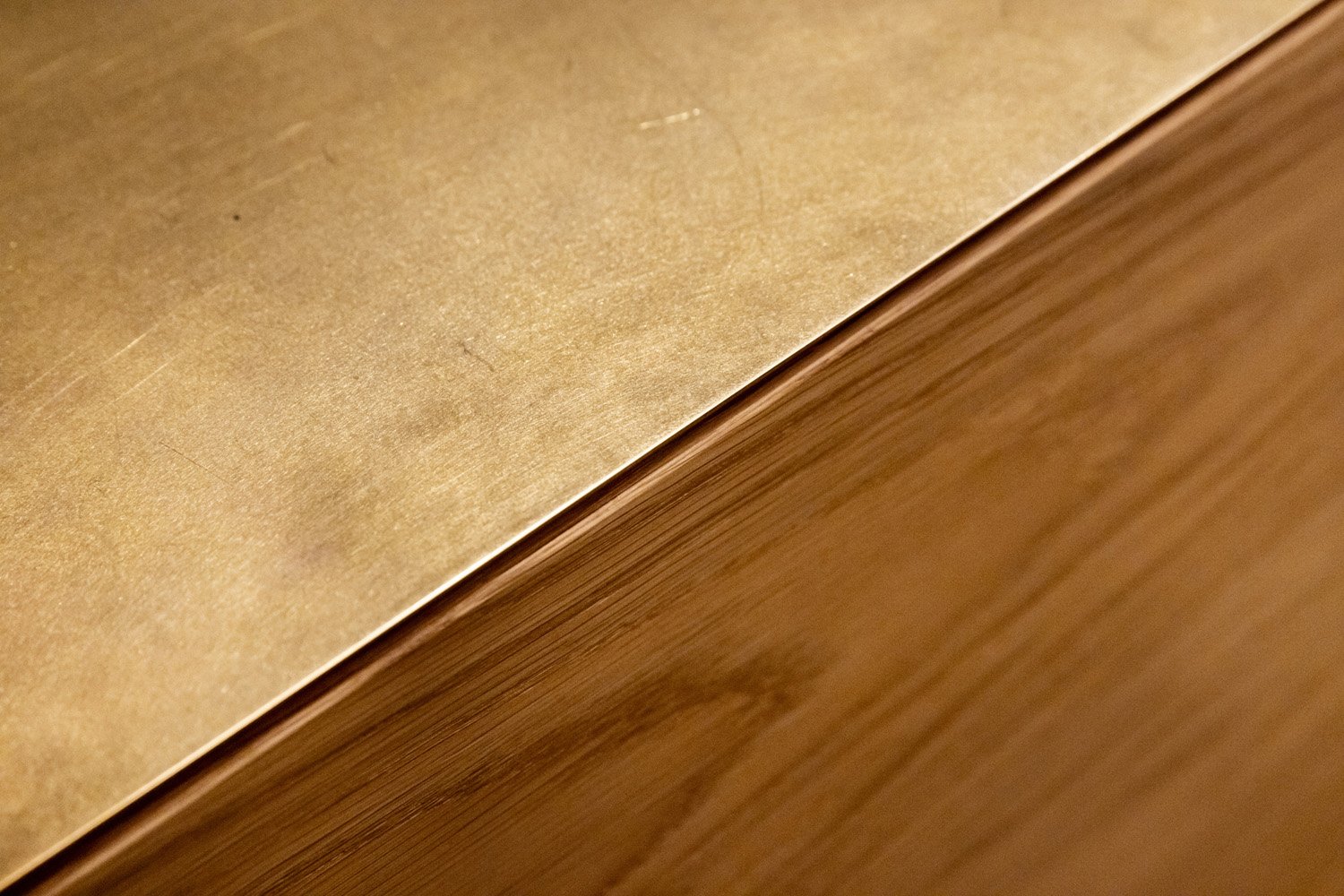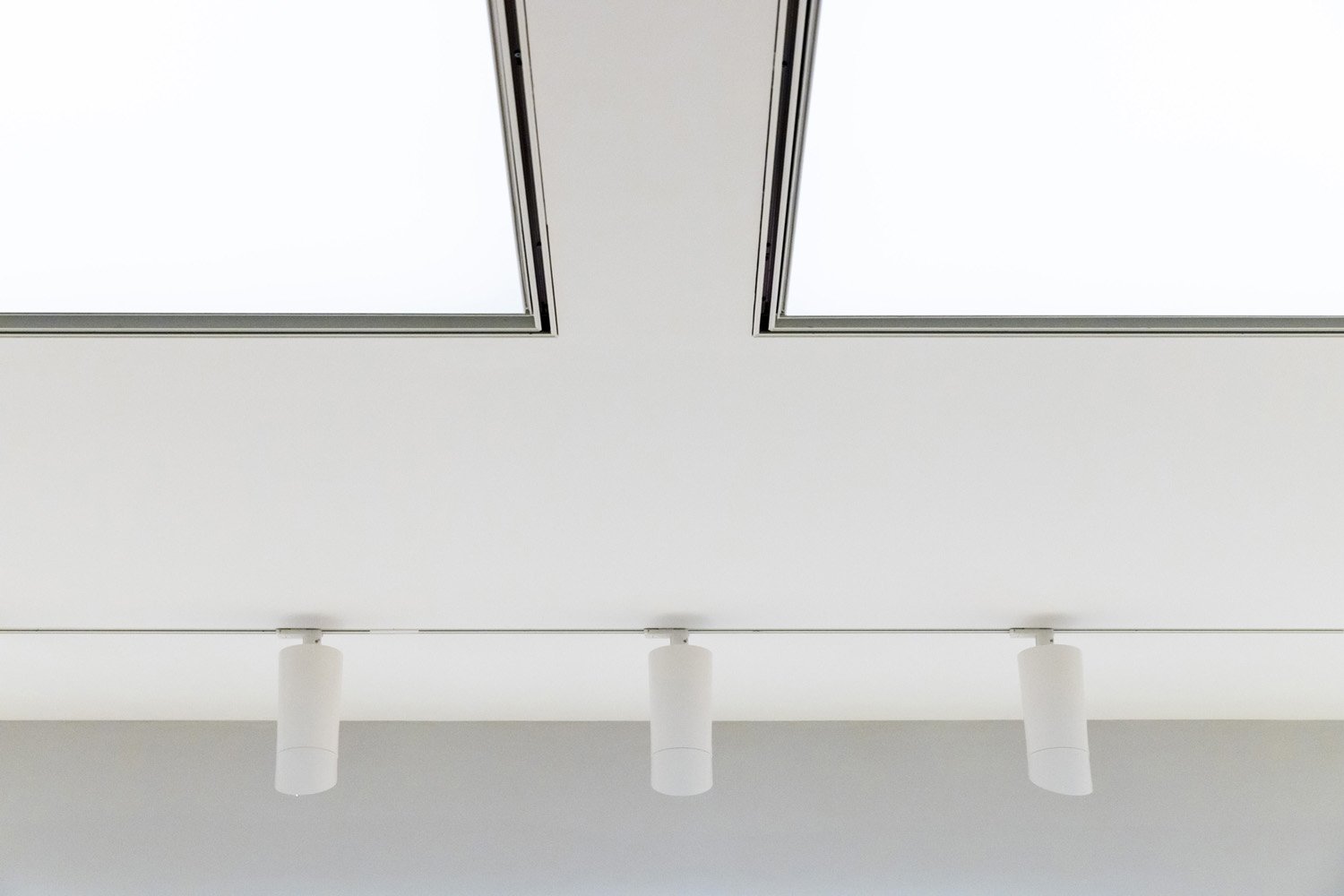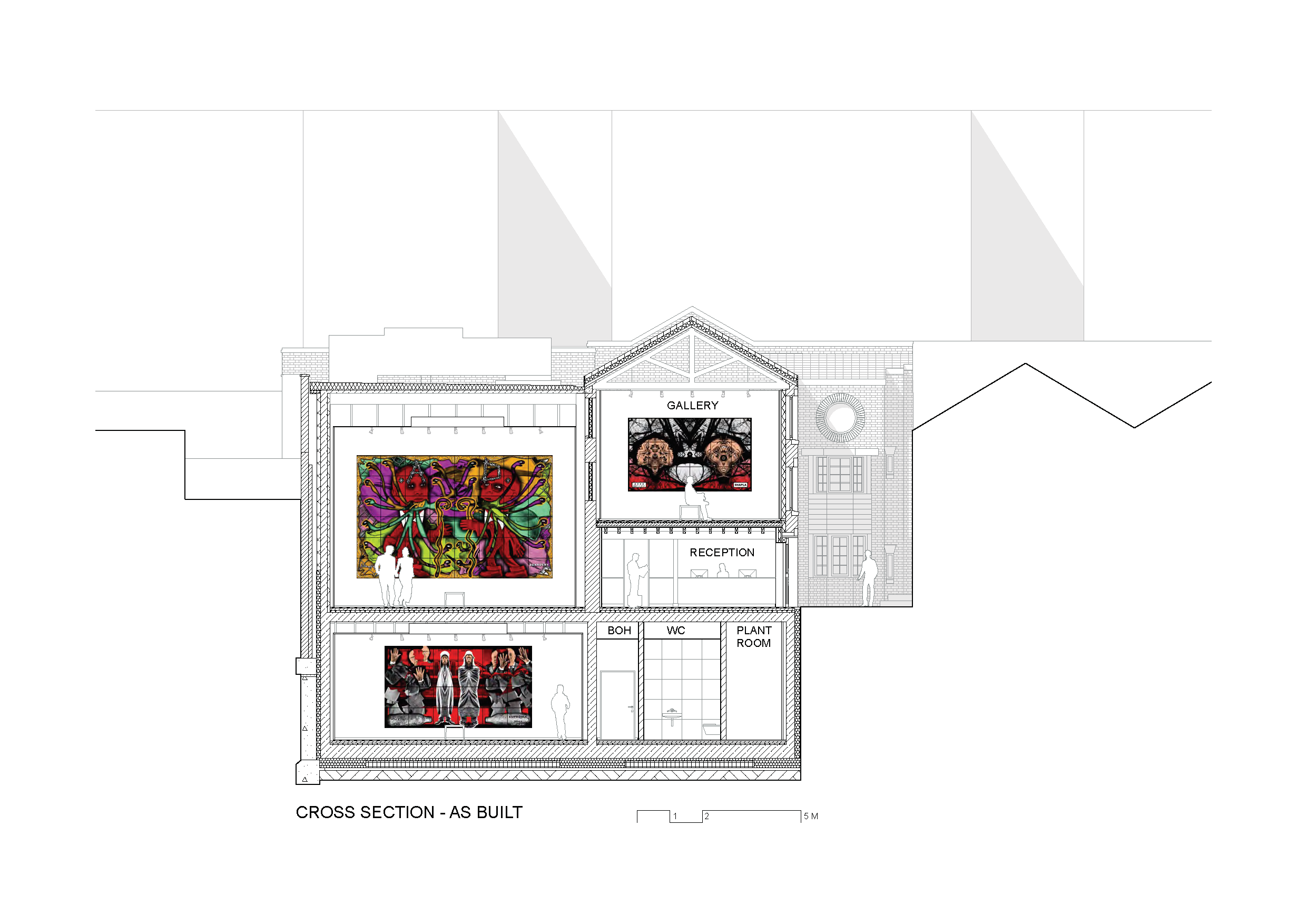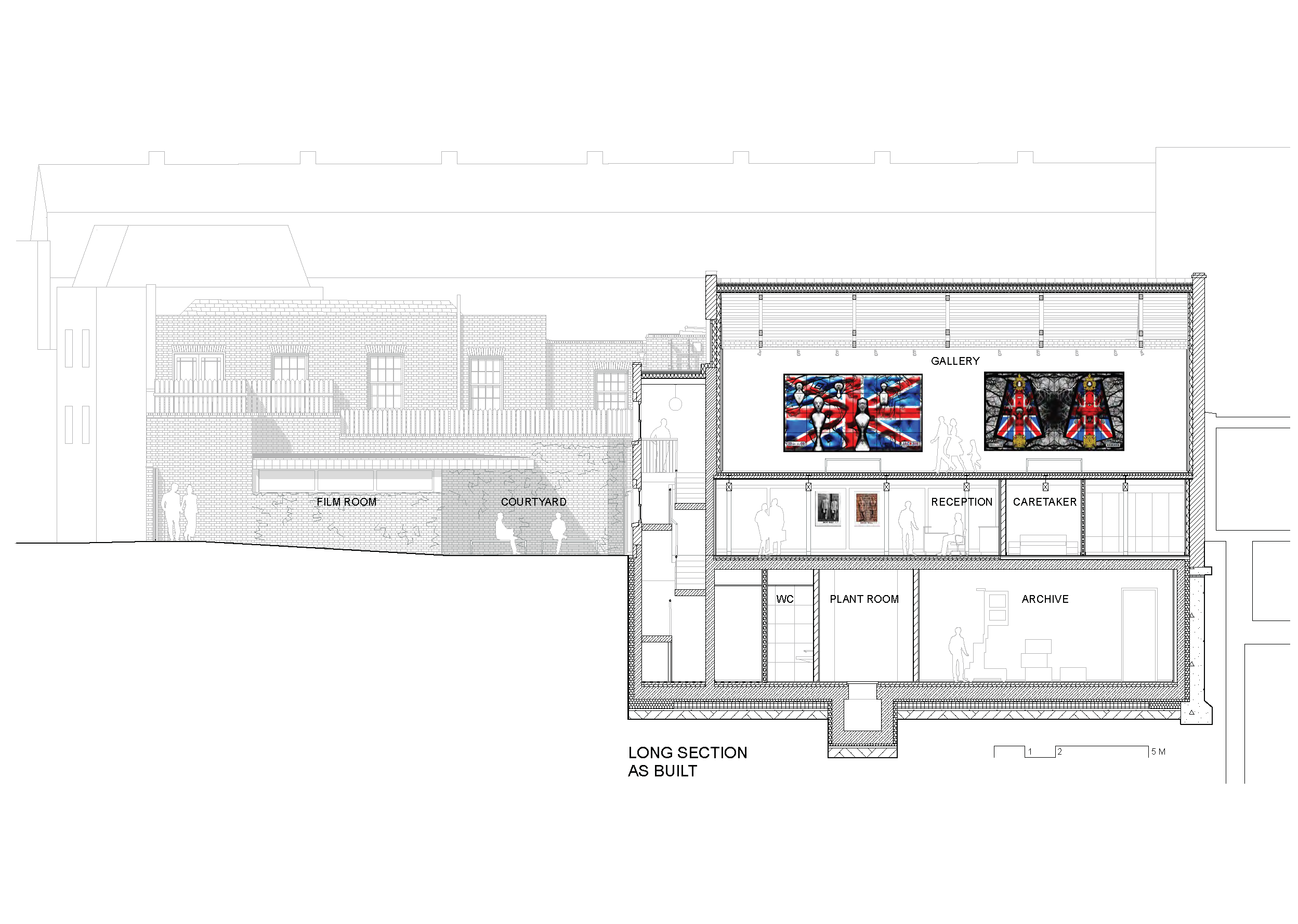THE GILBERT & GEORGE CENTRE
SIRS Architects have converted a former industrial building in London’s East End into Gilbert & George’s art foundation, breathing new life into the historic fabric of the area and seeking to immerse visitors in the unique realm of Gilbert & George.
“We are thrilled with the brilliant perfect Gilbert & George Centre. SIRS Architects have done an amazing job for us. Everyone loves it.” Gilbert & George
”Gilbert & George Centre - deceptively magnificent within a slice of the old East End. ..You walk through a door and, well, bang. The architecture fades away: this is a smooth white box with fine details, nice floors and benches, otherwise quiet in the extreme.” Edwin Heathcoate - Financial Times
”Ripper world meets the white cube. ..It requires some tact and restraint from the architecture to negotiate these many layers, which Irsara provides. …there are upward turns on the dial of classiness …quality materials that will age gracefully …precisely detailed exhibition galleries.” Rowan Moore - The Observer
“…Behind the gates, there’s an unexpectedly warm, even snug quality to the centre, with its courtyard like a village square. Gold and bronze lighting and subtly grey walls add to the intimate mood. It’s a lovely place to hang out, with remnants of old brickwork and Scandinavian wood amid the hi-tech…” Jonathan Jones - The Guardian
“…the renovation of the 19th-century building is everywhere on point. Details, including bespoke oak furniture and solid-bronze handrails, will delight design enthusiasts…” Alastair Sooke - The Telegraph“A Museum at the Center of the Gilbert & George Universe” Alex Marshall - The New York Times
The East End, located just beyond the boundary of the City of London, has long been a refuge for social minorities and immigrants, shaping a symbiotic yet unequal relationship with the city. Industries such as brewing, textile dyeing, tanning and metalworking, as well as entertainment venues like playhouses, pleasure gardens, circuses and music halls were prohibited within the city walls but thrived in the fringe area, attracting wealthy visitors to an otherwise squalid and overcrowded neighbourhood in the early 18th century. These public spaces became platforms for protest, dissent, religious nonconformism, trade unions, reformists, and revolutionaries. The stark contrast between opulent wealth and grim poverty was captured by Defoe and Dickens and depicted by Hogarth and Dore. Spitalfields was mainly fields until the late 17th century when streets were laid out.
The Gilbert and George Centre can today be found on the slender 18th century Heneage Street, just a stone's throw from Gilbert & George's current home and studio on Fournier Street, which is situated in the Brick Lane and Fournier Street Conservation Area. Upon arrival, visitors are greeted by a hand-forged wrought iron gate, designed by the artist duo themselves, before entering through a secluded, cobbled courtyard. A dimly lit reception area that resembles the artists nearby Georgian home, leads visitors to three contemporary exhibition spaces of different scale and feel that have been tailored to suit the artists' large-scale creations.
The Centre has been thoughtfully converted from an early 19th century former brewery building and the design philosophy reflects the artists' profound appreciation for London's architectural heritage. The building's restoration preserved many of its original features, some of which can be seen in a homely panelled reception area that showcases hand-crafted furniture and cast-iron components. Visitors can browse through a selection of the artists' publications, posters and prints and the leafy external courtyard features a film room that provides an introduction to the "World of Gilbert & George". By combining historic and contemporary elements, the project honours the building's industrial past and aligns with the artists' vision of architectural spaces and art display, seeking to immerse visitors in the unique realm of Gilbert & George through every detail.
To create sufficient space for the Centre's transformation on a restricted site, a basement level was built under the pre-existing footprint of the building and a new above-ground side extension was added. The underground level was constructed using a complex top-down methodology that involved striking the perimeter of 37 neighbouring parties, making it one of the UK’s largest party-wall awards at the time.
The building's design prioritises sustainable use of energy, water and material resources, taking into account socio-economic and lifecycle factors. Passive design principles included reducing the admittance of UV light and solar radiation into the building, incorporating high thermal mass into the building structure for stable internal conditions and using a high-performance, air-tight building envelope to minimise energy demands for heating and cooling. To reduce the carbon footprint, a range of active design principles were adopted, including the use of a digital BMS system with weather compensation, low-energy LED lighting with presence detection and automated control, an optimized recirculation ventilation system, photocatalytic paints and the use of harvested rainwater for horticultural irrigation. The building features permeable courtyard paving to support sustainable urban drainage, locally sourced and recycled materials, minimised demolition and the re-use of original site material. Collaboration with local companies & craftsmen in addition to in-house art storage facilities aim to reduce the impact of shipping.





















The Gilbert & George Centre aims to become a leading cultural institution in London and a hub for research and scholarship on the art of Gilbert & George, with a commitment to accessibility for all members of the community. The Centre opened to the public on 1 April 2023 with the inaugural exhibition of ‘THE PARADISICAL PICTURES’, welcoming nearly 40,000 visitors from across the globe.
Introducing The Gilbert & George Centre - A film by Lisa Immordino Vreeland, edited by John Northrup © Fischio Films, Lehmann Maupin
SIRS: Architects, Lead Designer, Principal Designer
Client: The Gilbert and George Centre
Date: 2015-2023
Floor areas: 602m2 GIA + 155m2 Ext
Construction & Fitout costs: £4,9 Mio
Location: London, UK
Photography: Tom Oldham, Prudence Cuming, Nic Serpell-Rand, SIRS Architects
Awards:
RIBA London Awards 2025 - Shortlisted
RIBAJ MacEwen Award 2025 - Longlisted
RIBA London Awards 2024 - Shortlisted
Civic Trust Awards 2024 - Regional Finalist
AJ Architecture Awards 2023 - UK Finalist (Cultural Project)
BDA Brick Awards 2023 - Shortlisted (Public Building)
BDA Brick Awards 2023 - Shortlisted (Refurbishment Project)
Archello Awards 2023 - Longlisted (Cultural Building of the Year)
Selected Media Coverage:
Financial Times
The Observer
Dezeen
Designboom
Wallpaper*
The Telegraph
Architects’ Journal
Baumeister Magazine
FX Magazine
Architecture Today
Elle Decor
Architectural Digest
S7 Magazine
Museums Association
The Guardian
Süddeutsche Zeitung
Arquitectura Viva
Archello
Corriere della Sera
The New York Times
CNN































